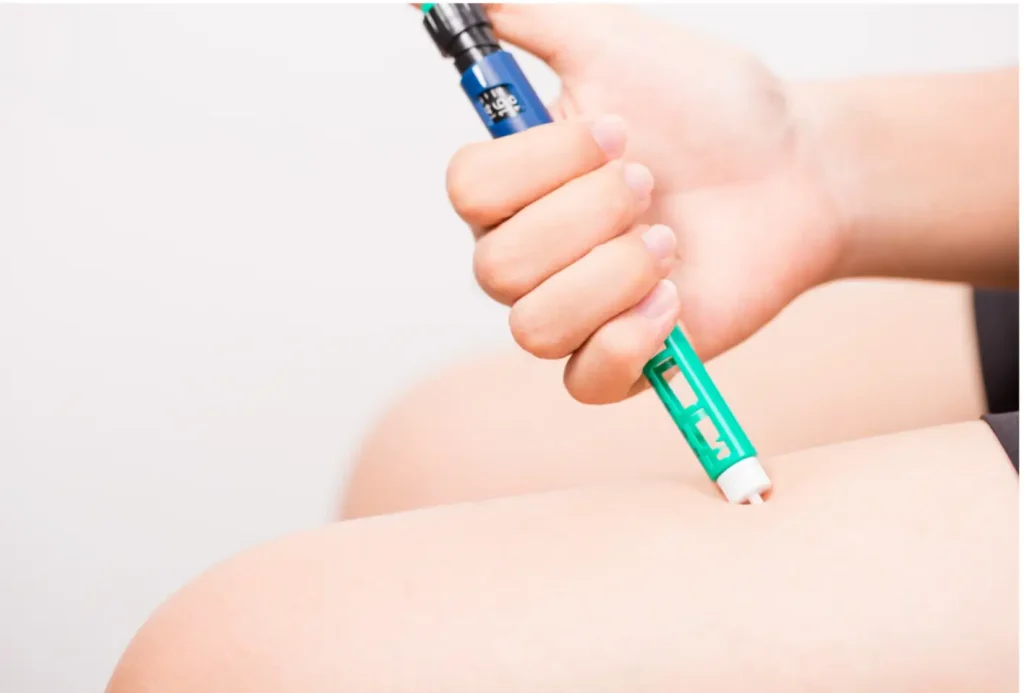Living with lupus can feel like carrying an invisible weight. Between fatigue, joint pain, and the impact of long-term medications, daily life is already a balancing act. On top of that, many people worry about weight changes, which can be influenced by both the disease itself and the treatments used to manage it.
That’s why new therapies like Saphnelo (anifrolumab) spark crucial questions. While clinical trials haven’t shown a direct link between Saphnelo and weight gain, patients often wonder if starting a new treatment, especially alongside corticosteroids, might affect their bodies.
In this article, we’ll explore what the research says, hear from patient experiences, and share strategies for staying on top of weight management while navigating lupus treatment with Saphnelo.
Key Takeaways
- Saphnelo (anifrolumab) is not directly linked to weight gain. Clinical trials, including TULIP-1 and TULIP-2, showed stable weight among most patients.
- Steroid-sparing benefits matter. In TULIP-2, 52% of patients on Saphnelo were able to reduce prednisone to 7.5 mg/day or less, compared with 30% on placebo—helping minimize a major cause of weight gain.
- Patient experiences confirm stability. Many report improved lupus control and fewer flares without significant changes in body weight.
- Other factors are usually to blame. Corticosteroids, reduced activity, hormonal shifts, diet, or metabolic conditions are more common reasons for weight changes.
- Monitoring and lifestyle strategies help. Tracking weight, staying active with low-impact exercise, eating a balanced diet, and getting quality sleep all support weight stability.
- Saphnelo offers a long-term treatment option. Available safety profile and data up to 4 years support its continued use, with the added benefit of reducing steroid dependence.
- Weight concerns should not be a barrier. With the right support and open communication, patients can manage their health effectively while staying on a treatment that helps control lupus.
About: Medical Spa RX provides medical practices with premium products at the best prices. If you’re looking to buy Saphnelo online for your practice, the sales representatives at Medical Spa RX can give you guidance.
Clinical Trial Data on Saphnelo and Weight Changes
Saphnelo (anifrolumab) has not been shown to cause significant weight gain in clinical trials. In both the TULIP-1 and TULIP-2 studies, participants generally maintained a stable weight while on treatment. Notably, the FDA’s clinical review also confirmed that weight-related side effects and symptoms were not a prominent issue.
One of the most meaningful findings came from the TULIP-2 trial, where Saphnelo demonstrated a steroid-sparing effect. Among patients taking high-dose prednisone or an equivalent at baseline, 52% of those receiving anifrolumab (45/87) were able to taper their dose down to 7.5 mg/day or less by weeks 40–52. This was compared to 30% (25/83) in the placebo group.
Since corticosteroids are a major contributor to weight gain, this reduction offers indirect support for weight stability in patients receiving Saphnelo.
Overall, the trial data indicate that while Saphnelo improves disease control, it does not appear to directly influence body weight in most patients.
Real-Life Patient Experiences
Beyond the numbers, hearing from real patients adds valuable context. Many individuals report improved symptom control without major changes in weight.
- Amit Tripathi: “I started Saphnelo November of 2022. Taking it every 4 weeks. It was hard for me play with my 5 year old due to joint pains and felt fatigued most days. The improvement was gradual with reduced flares and duration of flares over time…”
- B3ASTW0LF: Just got my 6th Saphnelo infusion yesterday. It is helping me a lot. I started with Benlysta too for nephritis, but it didn’t work for me. I do the Saphnelo once a month for 30 minutes.”
- MHH: “Have been dosing Saphnelo for about 2 years. Intervals change from once a month to once every two months while maintaining the effectiveness. Currently not taking any other medicine, and SLE flare is well under control until I missed the appointment.”
While experiences vary, both clinical evidence and lupus patient feedback suggest that Saphnelo does not directly cause weight gain. In fact, by reducing the need for steroids, it may support weight stability as part of lupus care.
Other Likely Causes of Weight Gain While on Saphnelo
If a patient experiences weight gain while using Saphnelo, it is often related to other factors. Many people with lupus are treated with multiple therapies, and some, especially corticosteroids like prednisone, are well known to cause increased appetite and fluid retention.
Additional Contributing Factors
- Reduced Physical Activity: Lupus flares, chronic fatigue, and joint pain can limit movement, lowering overall energy use.
- Hormonal Changes: Both autoimmune disease itself and certain medications can affect hormone balance, which influences metabolism and fat storage.
- Dietary Adjustments: Patients sometimes eat more to combat low energy or to cope with emotional stress, unintentionally adding excess calories.
- Underlying Conditions: Issues such as thyroid dysfunction, insulin resistance, or other metabolic disorders may also play a role in unexplained weight gain.
By considering these factors, a doctor and their patients can better identify the root cause of weight changes, rather than attributing them directly to Saphnelo.
Monitoring and Counseling for Weight Changes During Saphnelo Therapy
Even though Saphnelo is not strongly linked to weight gain, regular weight monitoring is a useful part of lupus management. Keeping track of weight helps distinguish between treatment effects, disease activity, and lifestyle changes.
Patients are often encouraged to record their weight weekly and share significant changes with their doctor. This allows the care team to determine whether fluctuations are linked to inflammation, reduced activity, dietary shifts, or other medications like corticosteroids.
Recommended Clinical Support

- Routine Check-ins: Doctors can discuss weight stability, nutrition, and energy levels during scheduled visits.
- Dietary Assessment: Reviewing daily intake helps identify imbalances or excess calories that may contribute to weight gain.
- Medication Review: Evaluating all prescribed treatments ensures no hidden contributors are overlooked.
- Behavioral Counseling: Addressing emotional health and stress eating empowers patients with practical coping strategies.
Counseling in a hospital plays a key role in empowering patients with practical strategies for maintaining a healthy weight. It also reinforces the importance of staying on effective lupus therapy without unnecessary concern. With collaborative care, patients can feel supported and confident in managing their health.
Strategies to Mitigate Weight Gain While Using Saphnelo
While Saphnelo itself is a drug not commonly linked to weight gain, patients with lupus may still face risks due to overlapping influences like reduced mobility, inflammation, or other medications. Taking proactive steps can help minimize those risks.
Practical Steps for Weight Management

- Balanced Diet: Focus on nutrient-dense foods such as lean protein, whole grains, fruits, and vegetables. Limit processed foods high in sugar, salt, and unhealthy fats.
- Regular Activity: Choose low-impact exercises like walking, yoga, or swimming to maintain strength and joint health.
- Adequate Hydration: Drinking water throughout the day can reduce unnecessary snacking and support metabolism.
- Sleep Hygiene: Good sleep regulates appetite hormones, boosts energy, and makes it easier to stay active.
- Medication Review: Discuss with a provider whether steroids or other drugs may be contributing to weight gain—sometimes adjustments are possible.
These lifestyle strategies not only help control weight but also improve energy, mood, and immune resilience, which are crucial for long-term lupus care. For those considering treatment choices, comparing Saphnelo vs Benlysta with a doctor may help identify which therapy or drug best aligns with their needs.
Conclusion
The current body of evidence indicates that Saphnelo is not directly associated with weight gain. Most patients tolerate it well without significant changes in body weight, and its steroid-sparing benefit may even support weight stability. When weight changes do occur, they are more often linked to corticosteroids, disease activity, or lifestyle factors rather than Saphnelo itself.
That said, ongoing monitoring, counseling, and healthy lifestyle choices remain key. Open communication between patients and providers ensures that potential issues are identified early and addressed appropriately.
For lupus patients considering or already using Saphnelo, concerns about weight should not be a barrier to treatment. With available long-term safety profile and data (up to 4 years) supporting its use, Saphnelo continues to offer an important therapeutic option—one that can be used confidently while keeping overall health, including weight management, in balance.
FAQs
1. Does Saphnelo directly cause weight gain?
No, clinical trial data show weight gain is not a common side effect of Saphnelo treatment.
2. Why might I gain weight while on Saphnelo?
Weight changes are often linked to corticosteroids, reduced activity, or lupus-related factors rather than Saphnelo itself.
3. How can I monitor weight changes effectively?
Track your weight weekly, record patterns, and discuss any notable increases with your healthcare provider.
4. Can lifestyle changes help with weight management?
Yes, balanced nutrition, regular low-impact activity, and proper sleep all support weight stability.
5. Should I stop Saphnelo if I gain weight?
Do not discontinue without medical advice. Most weight gain is due to other causes, not Saphnelo.
6. What should I discuss with my provider?
Talk about all medications you’re taking, lifestyle habits, and any concerns about weight or energy levels.
7. Is Saphnelo safe to use long term?
Yes, clinical studies support its safety for long-term lupus management, but ongoing monitoring remains important.
References
Ellis J, McHugh N, Pauling JD, et al. Changes in the incidence and prevalence of systemic lupus erythematosus between 1990 and 2020: an observational study using the Clinical Practice Research Datalink (CPRD). Lupus Science & Medicine. 2024;11(2):e001213. doi:10.1136/lupus-2024-001213
Lupus – Symptoms & causes. Mayo Clinic. Published October 21, 2022. https://www.mayoclinic.org/diseases-conditions/lupus/symptoms-causes/syc-20365789





















